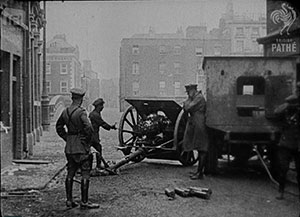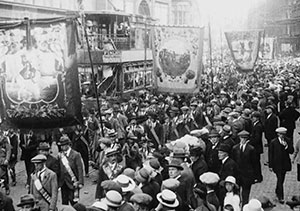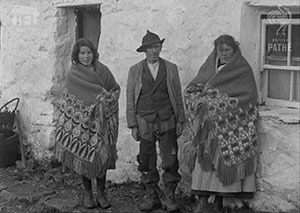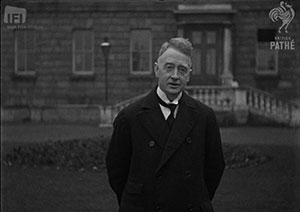The Irish Independence Film Collection
Published in Issue 4 (July/August 2018), Reviews, Volume 26Irish Film Institute, https://ifiplayer.ie/independencefilms/
By John Gibney

Above: Some film crews got very close to the action, such as those who filmed the National Army firing artillery at the Four Courts in June 1922.
Amongst the most famed instalments in Ireland’s cinematic history are George Morrison’s classic documentaries Mise Éire (1959) and its de facto sequel Saoirse? (1961), both produced by Gael Linn and adorned with equally classic soundtracks by Seán Ó Riada. The former explored the independence movement up to the 1918 general election, while the latter dealt with the War of Independence and the Civil War. They have stood the test of time extremely well. Modern viewers might quibble with the eulogistic tone of the narration to Mise Éire, though Saoirse? is, unsurprisingly, a bleaker, more sombre work. What gives them an enduring appeal is not necessarily the score or the narration so much as the approach Morrison took; both films are montages, constructed entirely from contemporary footage and imagery from the revolutionary period. There are none of the features that we now assume to be part and parcel of documentary film-making, such as ‘talking heads’ and ‘reconstructions’. It is a painstaking approach, but the viewer reaps the rewards of the effort made by the film-maker, though unfortunately it is all too rare (Julien Temple’s recent film Habaneros, on the Cuban revolution and its aftermath, is a notable recent example of this approach).

Above: Celebrating the 12th of July in Belfast—the collections cover the activities of Ulster Unionism.
This may seem like a tangent, but until May 2018 the easiest way for members of the public to view extensive footage from the revolutionary period was to watch Mise Éire or Saoirse? (Gael Linn released them on DVD a few years ago). This has now changed with the release of the Irish Independence Film Collection, developed by the Irish Film Institute. It is the latest addition to an ever-growing suite of on-line resources relating to the ‘Decade of Centenaries’, and is especially notable as it provides access to a remarkable vein of primary source material. The film in question consists of newsreel footage produced by British Pathé and Topical Budget, with the latter being held by the British Film Institute. Short newsreels with explanatory intertitles were usually produced at short notice and were shown in cinemas as an adjunct to the main feature. Some of these newsreels would have been available to view on-line via British Pathé, but the collection surpasses this limited access in range, scope and quality. The footage has been digitised in high definition from the original nitrate film stock, and the overall picture quality is excellent; if these comprise a window into the past, it is an exceptionally clear one. By collating them in this way and curating them thematically, the IFI has created a much richer vein of visual source material than was previously available to the public.

Above: One of the longer newsreels depicts the difficulties of life in Connemara in 1925.
The collection covers the period from 1900 to 1930 and the newsreels themselves are silent (with the exception of a short speech on the Irish Free State’s place in the world made by W.T. Cosgrave in November 1930, exclusively for British Pathé). The subjects range across the country, though Dublin looms large, as both the venue for major events and, presumably, as one of the easiest venues for British film crews to get to, although, as an indigenous Irish film industry had also sprung up, British newsreel companies sometimes relied on footage shot by Irish producers. The prospect of larger audiences in the capital’s cinemas may also have been a factor, though cinemas had sprung up throughout Ireland in the years prior to the First World War. By 1914 they were firmly established within the infrastructure of Ireland’s cultural life, showing a wide range of foreign as well as domestic features, which were accompanied by newsreels such as these.

Above: The newsreels are silent, with the exception of this short speech on the Irish Free State’s place in the world made by W.T. Cosgrave in November 1930.
The collection is very easy to explore and is broken down into five broad categories: Ireland before the Easter Rising, the Rising itself, the War of Independence, the Civil War, and finally a selection on Ireland from 1924 to 1930. The categories are interpreted broadly (the trial of Roger Casement is part of the Easter Rising gallery), and the geographical spread is very wide, extending far beyond Dublin as the focus of the collection moves forward through time. Nor is it just confined to the independence movement: the nature of the media naturally prioritises the dramatic events, and some film crews got very close to action (such as those who filmed the National Army firing artillery at the Four Courts in 1922), but the collections cover the activities of the labour movement and Ulster Unionism as well. Yet some of the most striking footage is of ‘ordinary’ life and social conditions as glimpsed between the major events: street scenes, with contemporary clothing and buildings visible. One of the longer newsreels depicts the difficulties of life in Connemara in 1925. Each piece of footage is contextualised in its own right with brief descriptive captions (useful for linking the footage to particular individuals and events), and there are also some extremely useful selections on major topics (such as 1918 and the Civil War) curated and contextualised by Ciara Chambers and Lar Joye.
All in all, it is difficult to do justice to the Irish Independence Film Collection, given the range and quality of the footage that it has been created to display. It is a remarkable treasure trove to explore, and serves as an invaluable visual archive that can act as a complement to the better-known and heavily publicised documentary sources for the Irish revolution. One hopes that it can be added to over time, perhaps with additional footage from the contemporary and home-grown Irish Events newsreel series, but there is plenty to explore in the meantime. This is a major achievement by the IFI and is a wonderful resource for discovering the reality of life in the Ireland that is being explored via the ‘Decade of Centenaries’.
John Gibney is DFAT100 Project Co-ordinator with the Royal Irish Academy’s Documents on Irish Foreign Policy project.
















